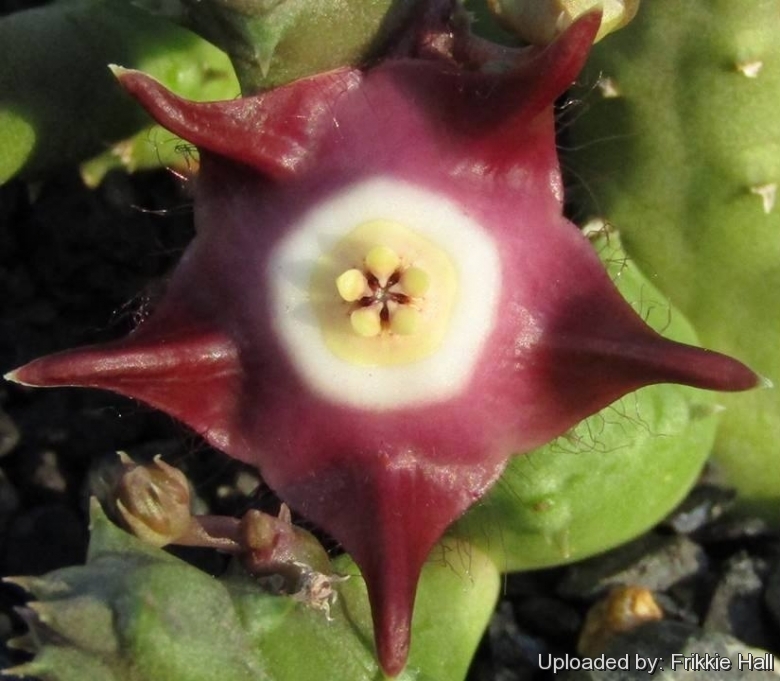
Duvalia pillansii Photo by: Frikkie Hall
Origin and Habitat: Duvalia pillansiiSN|30448]]SN|30448]] is known from five sites in the Eastern Cape (Hankey and Kirkwood), Republic of South Africa.
Habitat and Ecology: It grows on stony ground in thicket vegetation. The population is stable and there are no significant threats recorded.
Synonyms:
See all synonyms of Duvalia pillansii
back
Accepted name in llifle Database:Duvalia pillansii N.E.Br.Fl. Cap. (Thunberg) 4: 1026 (1905), 1909; Fl. Cap. (Harvey) 4: I. 1026 (1909)Synonymy: 2
back
Description: Duvalia pillansiiSN|30448]]SN|30448]] is a pretty succulent-plant of low growing and spreading habit. The colourful flowers are relatively large, when expanded 2-3.5 cm in diameter, dark chocolate passing into light purple on the top of the annulus and fading into a white ring around the pentagonal, light canary-yellow corona.
Derivation of specific name: The species was named to honor Neville S. Pillans, the well-known Cape botanist who first collected it at Cornell's Kop in the Richtersveld. Apart from D. pillansii, he is also commemorated in the genus Pillansia, as well as the species Carraluma pillansii, Aloe pillansiiSN|754]]SN|754]], Huernia pillansiiSN|21248]]SN|21248]], and Stapelia pillansiiSN|30273]]SN|30273]].
Stems: 1-5 cm long, 7-14 mm thick, ovoid to oblong-cylindrical, slender, green, obtusely 4- (rarely 5- or 6-) -angled. Angles with conical acute tubercle-like teeth 3-4 mm long with small leaf rudiments less than 1 mm long and stipular gland very small, sometimes absent.
Inflorescence: About the middle of the young stems with 2–3 slightly erect flowers, successively developed .
Flowers: With faint foetid odour. Pedicels usually about 6 (rarely up to 15) mm long. Sepals 2-4 mm long, ovate or ovate-lanceolate, acuminate. Corolla in bud deeply and acutely 5-lobed at the flat and rather thin basal part, abruptly acuminate into a very acute 5-grooved cone, when expanded 2-3.5 cm in diameter, dark chocolate or brownish-purple passing into light purple on the top of the annulus and fading into a narrow white ring around the corona. Corolla-lobes ascending-spreading, with recurving tips, 8-14 mm long and about 8 mm in breadth at the base, broadly deltoid-ovate with the sides but slightly folded back at the base, rather abruptly acuminate and replicate at the apical part, lamina glabrous on both sides, ciliate on the basal half with fine simple curved, purple hairs 2 - 3 mm long. Annulus circular to obscurely pentagonal, glabrous. Margins with smooth transition into the corolla-lobes, 0.2-3 mm high and 7-10 mm in diameter at the top, margin white to cream, papillose, hairs papillae 0.05 - 0.1 mm long. Outer corona, about 2.5-5 mm in diameter, pentagonal, light canary-yellow, cream or straw-coloured as are also the inner corona-lobes. Outer corona-lobes 1-1.5 mm long, 1.5 mm thick. Pollinia 0.35 x 0.24 mm. D. pillansii has been proved to be self-fertile.
Fruits: About 8 cm long, flies pollinated, the flowers resulting in the typical twin seed horns (follicles), which are decorative in themselves and often don't appear until a year later.
Blooming time: Flowers are freely produced throughout the late summer and autumn.
Seeds: 4.5-5.5 mm long, 3 mm thick, wings often marginate.
Bibliography: Major references and further lectures:
1) Victor, J.E. & Dold, A.P. 2005. Duvalia pillansii N.E.Br. National Assessment: Red List of South African Plants version 2014.1. Accessed on 2015/02/08
2) Meve, U. 1997. “The genus Duvalia (Stapelieae): Stem-Succulents Between The Cape And Arabia.” Plant Systematics and Evolution Supplement 10:1-132. Springer, Vienna.
3) Bruyns, P.V. 2005. “Stapeliads of southern Africa and Madagascar.” (Vol. 1, pp. 1-330). Umdaus Press, Pretoria.
4) N. E. Brown “Flora Capensis”, Vol 4, 1909
5) Focke Albers, Ulrich Meve “Illustrated Handbook of Succulent Plants: Asclepiadaceae: Asclepiadaceae” Volume 4 Springer, 2002
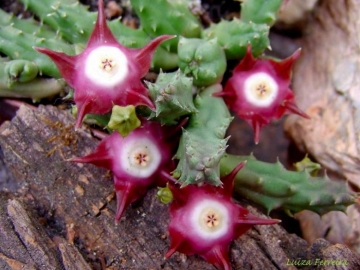 Duvalia pillansii Photo by: Luiza Ferreira
Duvalia pillansii Photo by: Luiza Ferreira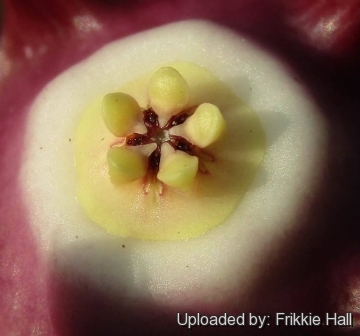 Duvalia pillansii Photo by: Frikkie Hall
Duvalia pillansii Photo by: Frikkie Hall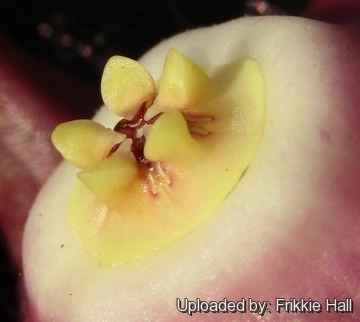 Duvalia pillansii Photo by: Frikkie Hall
Duvalia pillansii Photo by: Frikkie Hall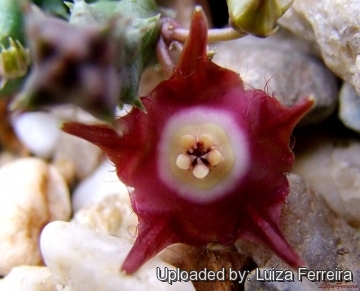 Duvalia pillansii Photo by: Luiza Ferreira
Duvalia pillansii Photo by: Luiza Ferreira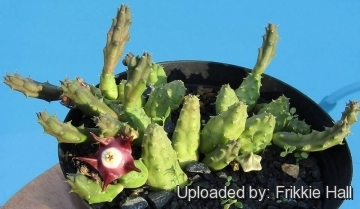 Duvalia pillansii Photo by: Frikkie Hall
Duvalia pillansii Photo by: Frikkie HallSend a photo of this plant.The gallery now contains thousands of pictures, however it is possible to do even more. We are, of course, seeking photos of species not yet shown in the gallery but not only that, we are also looking for better pictures than those already present.
Read More... Cultivation and Propagation: Duvalia pillansiiSN|30448]]SN|30448]] is a tiny, but easy obliging blooming plant when mature, that it is happy in any average succulent house. This species favours more humid conditions than other duvalias.
Potting: Since roots are quite shallow, use a soft and incoherent cactus mix or add extra perlite or pumice to regular soil potting soil, and clay pots help the plants to dry out between watering.
Waterings: Duvalia require moderately watering through the growing season but enjoy plenty of water and some fertiliser in hot weather, this helps them to flower freely. Water more sparingly in winter according to temperatures. But, as with most asclepiads, it is unwise to leave them wet in cold weather.
Fertilization: Fertilizers for succulent plants must be rich in potassium, but poor in nitrogen, to avoid the plants from developing excess vegetation, which is easily attacked by fungal diseases.
Sun Exposure: As with many succulents, they prefer to grow in the light shade of scrubby shrubs or between rocks where they get some shade during the day. In summer it is advisable to position this plant in a partially shady place, where it is exposed to direct sunlight only during the coolest hours of the day.
Hardiness: These plants don't like cold weather, therefore in the Spring it is best to set them outside only when the temperatures are above 15°C. Can endure temperatures below 5°C for short period, but only if the soil stays completely dry.
Pest and diseases: Duvalias species vary in their susceptibility to rotting, but are generally fairly easy to grow, especially if kept pest-free. They are very susceptible to stem and root mealy bugs, and damage from these may well initiate fungal attack. If you do have problems with a stem or with basal rotting, you can reliably isolate the healthy parts, dry them off, and re-root them in moist compost.
Cultural Practices: Re-pot every 2 years.
Propagation: Easiest with stem cuttings. Allow cuttings to dry a day before planting. Stems must be laid (Not buried) on gritty compost and will then root from the underside of the stems. It can also be increased from seeds sowing in spring in moist, sandy peat moss. Barely cover seeds. Seeds germinate quickly.















